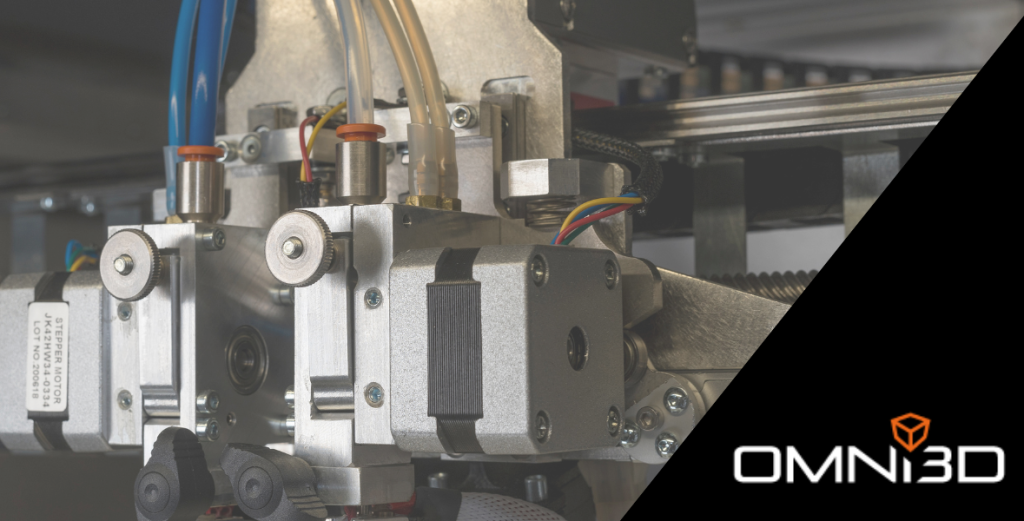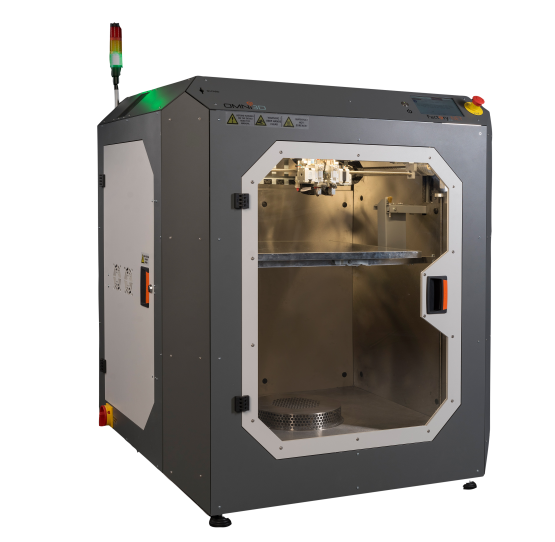Polish 3D printer manufacturer Omni3D has patented a technology called the ‘Omni3D Cooling System’ that enables users to cool their Fused Filament Fabrication (FFF) machine’s extruders more effectively.
By stabilizing filament temperature during feeding and deposition, Omni3D says its combined extruder, printhead and assembly system delivers parts with “significantly better quality.” Having been awarded a US patent for the technology, the company now expects it to gain traction in a market with an already lucrative FFF 3D printing sector.
“At Omni3D, we want to deliver the best in class 3D printing solutions needed to produce prints with exceptional dimensional accuracy and stability,” says Paweł Robak, CEO of Omni3D. “I’m proud that we can bring additional value to the 3D printing community and that our patent is now approved in the US market. We believe our solution represents an important improvement to the extrusion process.”

Omni3D’s FFF printing portfolio
Since being founded in 2013, Omni3D has expanded its reach dramatically, and its client base now ranges from multinationals such as Siemens and MAHLE, to defense contractors like BAE Systems. At present, the firm’s offering includes multiple versions of its Omni200, Omni500 LITE, OmniSTART and Factory 2.0 units, as well as filaments, designed to meet industrial, automotive and educational needs.
With its Omni3D series machines, the company has launched a set of user-friendly systems with scaling capabilities and capacities, so that adopters can choose the one that best suits their use case. While the entry-level OmniSTART has a 200 x 200 x 150 mm build volume and maximum printhead temperature of 260°C, the more capable Omni500 is larger, and its printheads can safely operate at 360°C.
For engineers seeking an FFF 3D printer that can take on more demanding applications, Omni3D’s Factory 2.0 machines are even bigger. These feature 500 x 500 x 500 mm build volumes, and come fitted with enclosed heating chambers. As a result, the Factory 2.0 is capable of creating large-format prints from the engineering-grade Thermec Zed, in addition to ABS and CPFA industrial thermoplastics.
Previously, the firm’s technology has been applied to 3D print prototypes for the Hussarya, a Polish supercar that was constantly redeveloped, going from an initial design to a road-legal GT3 race car in eight years. In more end-use applications, Omni3D has also partnered with the Cyprus University of Technology, to develop a 3D printed biofuel reactor capable of turning carbon dioxide into alternative fuels.

The Omni3D Cooling system
Despite FFF being the most popular form of 3D printing on the market, Omni3D says there are still many areas of the technology that require further research. One area in particular that the firm has identified as a nuisance to users is extruder overheating. In the absence of cooling, the company points out that filaments can heat to softening temperature, causing them to deform inside an extruder’s feeding zone .
This, in turn, could lead an extruder’s gear system to ‘bite’ into materials, in a way that effectively changes the amount fed, culminating in inconsistent prints. To get around this overheating problem, Omni3D has come up with a way of cooling the extruder at the point in which the filament is ‘gripped’ between pressure bearing and gear, that facilitates stable and repeatable plastic extrusion.
In the process of doing so, the company discovered that the key to stabilizing extrusion temperatures is improving the working conditions of FFF machines’ knurled-filament-clamp systems. These need to stay cool enough to ensure the right force is used to press filaments into printheads, thus to make this possible, Omni3D has developed an extruder design with a body that also takes the role of heat sink.
Effectively, the firm’s extruder works by absorbing thermal energy via its body, before transmitting this through cooling liquid to a cooler, which ejects any excess heat out into the environment. By creating the system from titanium and aluminum, and bypassing the need for a dedicated heat sink, Omni3D has managed to make it both lighter and more compact, benefits that have also increased its throughput.
At the same time, the extruder works to minimize the risk of materials softening at the wrong stage, reducing the chances of over or under-extrusion, while improving the operation of FFF printers’ motors. Compared to just using g-code material settings, the system is also said to provide users with greater control over filament feed quantity and print accuracy.
“The basic idea of the system was to lower the temperature of the filament in the heated chamber,” explains Krzysztof Kardach, Chief Technologist of Omni3D. “By stabilizing it at a temperature far from being softened, the filament is transported more stably by the extruder to the nozzle. This functionality allows our printers to work with a variety of filaments and allows greater control over the feed pressure of the plasticized filament.”
“By cooling the extruder in the place where the filament is ‘caught’ between the pressure bearing and the extruder gear, we obtain a very stable and repeatable amount of extruded material,” he adds. “In the absence of cooling, the filament in the extruder may heat up to the softening point. The heated filament after compression in the extruder may deform from a circular cross section to an elliptical, and the gear will ‘bite’ more; thus changing the effective amount of material fed.”

A US-patented extruder design
Having integrated this extruder design into its 3D printers, Omni3D has now patented it in the US as well. Awarded under patent number ‘US 2019/0184633 A1,’ the firm’s first patent in the country not only covers its heat-dissipating extruder design, but a modular head assembly system that works to further protect against potential print errors.
In practice, the device’s dual-head layout does so by making it easier to switch printheads, while enabling users to control the softening temperature parameters of two filaments simultaneously. In addition to enabling different types of materials to be used for a part’s base and supports, the system also helps keep them cool both before and during feeding, in a way that yields better process stability.
“Thanks to the use of this patented technology, the Omni3D system is not only one of the most versatile in its application, but through its cooling elements, we stabilize the operation of the entire printer,” concludes Tomasz Garniec, Global Sales Manager of Omni3D. “This, along with the technological aspect, makes equipped Omni3D printers devices that have a greater feeling of the process, and guarantee stability for many hours of printing.”
Nominations for the 2022 3D Printing Industry Awards are now open. Who do you think should make the shortlists for this year’s show? Let us know by casting your vote now.
To stay up to date with the latest 3D printing news, don’t forget to subscribe to the 3D Printing Industry newsletter or follow us on Twitter or liking our page on Facebook.
While you’re here, why not subscribe to our Youtube channel? featuring discussion, debriefs, video shorts and webinar replays.
Are you looking for a job in the additive manufacturing industry? Visit 3D Printing Jobs for a selection of roles in the industry.
Featured image shows a printhead with the Omni3D Cooling System. Photo via Omni3D.



